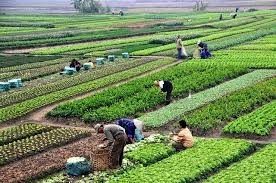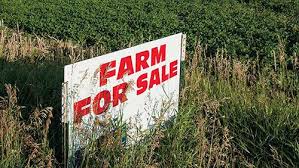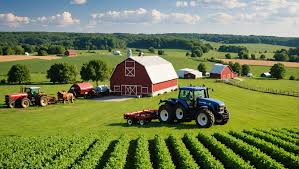In this article, the five external sources of acquiring capital for farmers will be explored.
1. Incorporation as a Method of Acquiring Capital

Forming a corporation provides another method of acquiring capital for farming. A corporation is a legal entity authorized by State law capable of doing business, making contracts, borrowing money, and similar activities, just like an individual proprietor. The procedure for forming a corporation is outlined in the law and should be followed exactly. For this and other reasons, the services of a competent lawyer are essential for incorporating a business.
Individuals who form a corporation are its owners and are issued certificates representing shares to show the interest each holds in the corporate assets. The shareholders elect directors to represent them in business policy and management decisions. The directors, in turn, employ officers who operate the business according to the policy established by the directors.
Incorporation is a possibility in any business of reasonable size. Many family farms are large enough to at least consider incorporating. However, only larger farms have found incorporation advantageous. Incorporation attracts taxes at both state and federal levels.
When a corporation is formed to operate a farm business, it takes the place of the farmer as owner and operator. An individual may manage and operate the farm like any farmer, but he does so as an employee of the corporation, not as an individual entrepreneur.
Advantages of Incorporation for Farm Business
A corporation provides a means by which a group of individuals may pool their funds and operate a business. Members of a family may organize a corporation to operate the home farm and to facilitate its transfer to a son or a son-in-law without disrupting the business.
Other individuals may also form a corporation to carry on a farming operation. For example, two or more families with inadequate capital to farm efficiently on an individual basis may use the assets they have to advantage by pooling them in a farm corporation.
In addition to serving as a means of obtaining capital, incorporation of the farm business may serve to hold the article together and permit continuity of operation from one generation to the next. This feature assumes added importance as the size of the business increases.
Should one shareholder of an incorporated business die or decide to sell out, there is no need to break up the business, as in a partnership. The stock may merely be transferred to a new owner.
This ability to transfer ownership of undivided interests provides an easy means for children and others to buy into a farm business. It also facilitates estate planning by permitting parents to divide and transfer estates without reorganizing the business.
Some fringe benefits may be obtained through incorporation with advantages in terms of benefits and taxes. Since social security benefits are based upon earnings of individuals in the United States of America, it may be advantageous for a farm operator to receive a constant salary even though the corporation may show a loss.
The availability of profit-sharing and pension plans may favor the corporate form of business in some instances. For example, with a qualified pension plan, some corporate profits can be used to provide retirement income for employees even though they are stockholders.
The corporation pays no tax on earnings applied to the pension plan, and the employee is taxed only when he receives the retirement benefits. Somewhat similar benefits accrue from medical payment plans, employee death benefits, and group life insurance.
This article is linked to the broader context of Farm Business, highlighting how strategic financial decisions like incorporation can significantly impact the sustainability and growth of agricultural enterprises.
Disadvantages of Incorporation for Farm Business
There are some problems or disadvantages associated with incorporating a farm business, which should be carefully and thoroughly considered. For example, unless proper safeguards are included in the legal framework, the business might not be managed in the best interests of minority stockholders.
Some expenses are involved in incorporating, and a corporation may pay certain annual fees and taxes that are not required of other types of business organizations.
Furthermore, some expenses are involved in maintaining records of the corporation and in filing the corporate tax returns. Annual meetings must be held, directors and officers elected, and an annual report of the business filed with the appropriate government body.
Read Also: 7 Medicinal Health Benefits of Daffodils (Narcissus Plant)
2. Renting as a Method of Acquiring Capital for Farm Business

Renting or leasing is a common way of obtaining additional capital for farming. Tenancy is often thought of as the second rung on the ladder of farm ownership. A young farmer can work, learn, and save until he has enough know-how and capital to obtain and manage a line of machinery and livestock.
With this, he is in a position to rent a farm and begin operating on his own. And, of course, renting does not always stop when farm ownership is attained. Many landowners and ranchers, who own considerable land, rent additional acreage to utilize more efficiently their managerial ability, the land, machinery, and equipment they own.
Types of Leases in Farm Business
Leases are usually classified according to the kind of rent paid. Most of them fall into three general groups: the crop-share lease, the livestock-share lease, and the cash lease. With share leases, a share of the crop or livestock production is paid to the landlord as rent. With a cash lease, the agreed-upon rent is paid in cash. The various types of leases may be combined or otherwise modified in renting a farm. A common method is to give a share of the grain crops as rent.
1. Crop-Share Lease
The crop-share lease is the most common type of rental arrangement. With the crop-share lease, the landlord usually provides the land and improvements and pays related taxes and other expenses, while the tenant pays most of the operating expenses and furnishes power, machinery, labor, and livestock. Some expenses, such as seed and fertilizer, may be shared with the landlord. Crops produced are shared as agreed upon in the lease.
2. Livestock-Share Lease
For farms rented under a livestock-share lease, the tenant and landlord customarily share crops and livestock production as well as some of the expenses. The landlord usually furnishes the land, buildings, and other improvements; the tenant furnishes the machinery, power, and his own labor.
The tenant and landlord commonly own the livestock jointly and share the annual expenses of crop and livestock production. The livestock is most often owned on a 50-50 basis, and expenses and income are shared in the same proportion.
3. Cash Lease
Farms rented by cash lease tend to be used most frequently in areas where yields are relatively stable and where production involves a relatively small amount of risk and uncertainty. They are also frequently used for part-time or residential farms.
With cash leasing arrangements, the landlord is paid a specified cash payment and usually furnishes the land, buildings, and other improvements. The tenant furnishes all other items required for production, including labor, machinery, livestock, and operating expenses. The entire production of crops and livestock belongs to the tenant.
4. Standing Rent
The concepts of cash and share rent are sometimes combined in what is called standing rent. A fixed rent is agreed upon, but in place of cash, payment is made in a fixed measure of products, such as one-third bale of cotton, 5 bags of maize, or tins of palm oil.
The naira amount of rent the landlord receives varies with the price of the product, as it would with share rent, but the amount of product he will receive is known in advance. Thus, the landlord has greater security in years of low yield, while the tenant makes more profit in years of high yield.
Special Case: Cocoa Farms in Western Nigeria
On cocoa farms in Western Nigeria, the renter typically retains most food crops like cocoyam, yam, banana, and plantains but shares palm oil produced with the landlord and pays cash for the cocoa beans proportionally as stipulated in the agreement.
Advantages and Disadvantages of Obtaining Capital by Renting
There are several advantages and disadvantages to renting, as with all methods of obtaining capital.
Advantages for the Tenant
1. Control of Capital with Minimal Risk: The tenant can control a large amount of capital with relatively little risk.
2. Managerial Assistance: The tenant may benefit from the landlord’s managerial expertise.
3. Efficient Production: Renting can provide access to a more adequate farm unit, facilitating efficient production.
Disadvantages for the Tenant
1. Uncertainty of Tenure: Leasing a farm involves uncertainty regarding long-term access to the land.
2. Inadequate Living and Farm Improvements: Living accommodations and farm improvements are often inadequate.
3. Rental Arrangements: Rental terms may not always contribute to efficient or maximum production.
4. Rent Payments: The tenant must pay cash or share rent, which compensates the landlord for property assessments, maintenance, depreciation, and a return on investment.
3. Purchase or Purchase Contracts

If the buyer has sufficient funds, they can pay for the property in full, and all documents are signed and handed over. This is the most common method in Nigeria. A purchase contract provides another method of supplementing one’s capital.
The contract may be known by various names, such as a contract for sale, conditional sales contract, or land contract, depending on local terminology and the type of property involved. Such an instrument is used when the down payment is too small for the buyer to obtain title by financing part of the purchase price with a mortgage. For example, roughly 50% of the purchase price of real estate may be required as a down payment to obtain financing with a mortgage.
Terms of a Purchase Contract
A purchase contract is a written agreement whereby one party agrees to convey land and sometimes chattel farm property to another party for an agreed price. Possession of the property passes to the buyer, while the deed remains with the seller, to be delivered at a future date or upon payment of a specified amount.
The contract usually requires the buyer to maintain or make improvements on the farm. Where livestock are involved, provision is typically made for all livestock raised or purchased to be considered replacement equipment, legally belonging to the seller until the contract terms are fulfilled. The buyer usually pays all expenses, including taxes and property insurance after a specified date.
The kind and amount of insurance are typically specified, with the loss-payable clause in the name of the seller. This implies that only the wealthy or those with access to bank financing can make such purchases unless they opt for a purchase contract.
Advantages of Purchase Contracts
A. From the Buyer’s Viewpoint
1. Low-Equity Financing: The purchase contract provides a means of low-equity financing, allowing families to acquire a farm earlier than by waiting to accumulate capital.
2. Lower Price in Rising Markets: It enables families to acquire a farm at a lower price during periods of rising farm prices.
B. From the Seller’s Viewpoint
1. Higher Selling Price: The contract may facilitate selling the farm at a higher price.
2. Retained Investment: The seller retains an investment in a familiar business, maintains some control, and receives regular periodic payments.
Disadvantages of Purchase Contracts
1. Insecurity of Ownership: Since legal title remains with the seller, the buyer may feel insecure about ownership.
2. Heavy Payments: Total payments are relatively heavy for the buyer, considering costs of repairs, improvements, taxes, and insurance
3. Risk of Losing the Farm: If the buyer cannot meet installment payments, they may lose the farm.
4. Frozen Assets: Assets of both buyer and seller may become “frozen” during the initial years of the contract, making it difficult for the buyer to sell accumulated equity.
5. Depleted Operating Capital: Due to heavy payment schedules, operating capital may be depleted, preventing the buyer from following good farm management practices.
Read Also: Bacterial Canker (Stone fruit trees): Description, Damages Caused, Control and Preventive Measures
4. Vertical Integration and Contract Farming

Vertical integration involves bringing together under central management two or more links in the chain of production and marketing. A farmer whose operations are vertically integrated shares managerial decisions with related businesses, such as suppliers, processors, or distributors.
In return, the integrator provides financing and assumes associated risks. This linking of production and marketing stages is often accomplished through contractual arrangements, sometimes called contract farming.
Vertical integration is not new in agriculture. Contracts have long been used for cannery crops, sugar beets, and similar products in developed countries. However, arrangements where the supplier, processor, or distributor takes over farm production operations are relatively new.
The importance of vertical integration varies among commodities. For some, only a small proportion of farm output is produced under integration, while for others, nearly 100% is integrated.
For example, roughly 95% of broiler production occurs on an integrated basis. Integration and contracting trends in livestock are less advanced but still evolving. Integration develops when regular farm production fails to provide needed market outlets or farm products of proper specifications at reasonable prices.
Advantages of Obtaining Capital through Integration Contracts
1. Specialized Management: The integrator assists with or takes full responsibility for management, facilitating more efficient production.
2. Risk Sharing: Risks are shared with or transferred to the integrator, making them more manageable.
3. Increased Enterprise Size: More capital allows for larger enterprises, contributing to greater efficiency in labor and equipment use..
4. Continuous Production: Specialized management and capital facilitate continuous production, making efficient use of buildings, equipment, and labor.
5. Time for Other Enterprises: Transferring management responsibility leaves the farmer more time for other enterprises.
6. Higher Income: Enlarging an enterprise through contracting may provide additional income for the operator and family members.
7. Access to Rural Life: Contract farming offers families with limited resources the opportunity to live and work in a rural setting without providing all the capital or carrying all the risks.
8. Better Breeding and Seed Varieties: Larger enterprises allow for better breeding stock and seed varieties, resulting in higher-quality products.
9. Specialized Equipment: The integrator can use highly specialized equipment, which would not be feasible for individual farmers.
10. Efficient Resource Use: Coordination of production and marketing phases contributes to efficient resource use and management.
11. Orderly Production and Marketing: Integration may facilitate more orderly production and marketing of agricultural products, aligning production with demand.
Disadvantages of Obtaining Capital through Vertical Integration
1. Loss of Management Control: The farmer may lose freedom in making management decisions for the integrated enterprise.
2. Lower Returns: Shifting risks and management to the integrator may result in lower returns for the farmer.
3. Reduced Autonomy: The farmer may become little more than a hired hand, with limited decision-making power.
4. Overextended Credit: Competition among suppliers may lead to overextended credit used as a sales tool.
5. Limited Market Gambling: The farmer may lose the opportunity to “gamble” on the market for higher profits.
6. Complicated Farm Planning: Integration may complicate farm business planning and finances.
7. Neglect of Other Enterprises: If priority is given to the integrated enterprise, other enterprises may suffer, reducing overall net income.
5. Borrowing as a Method of Acquiring Capital

The word “borrow” means to receive something with the understanding that it or its equivalent will be returned as agreed. Borrowing involves obtaining funds to be repaid as specified in a note. Credit, derived from the Latin word “credo” (meaning “I believe”), is based on confidence in the borrower’s ability to repay.
Borrowing ranks next to saving or using one’s own capital as a means of obtaining capital to farm. Few commercial farmers operate without using credit. Borrowing allows greater flexibility than renting, as it can be used to acquire any type of resource or service needed by the farmer. However, borrowing involves more risk of losing owned capital than renting, as payments typically include both interest and principal.
Advantages and Disadvantages of Borrowing in Farm Business
Borrowing is a critical tool for farmers to acquire capital, but it comes with both advantages and disadvantages. Understanding these can help farmers make informed decisions about using credit to support their operations.
A. Advantages of Borrowing
1. Facilitates Farm Ownership and Advancement: Without credit, tenant farmers would be forced to give up farming and hire out as laborers or seek other work. Owner-operators with mortgaged farms would lose their homes and farmland, reverting to tenancy with its inherent insecurities.
Borrowing enables hired hands to become tenants and tenants to become owners, allowing farmers to climb the agricultural ladder.
2. Access to Capital for Young Farmers: Young, competent farmers between the ages of 20 and 35 often have the training, experience, and energy needed for farming but lack the necessary capital. Borrowing bridges this gap by allowing them to access funds from lenders such as retired farmers, widows, banks, insurance companies, and other capital-owning groups.
3. Interdependence of Management and Capital: Farmers with management skills and lenders with capital are interdependent. Successful farming requires both, as neither group can operate effectively alone.
4. Enables Investment in Modern Resources: Credit allows farmers to invest in new machinery, high-quality seeds, fertilizers, livestock, and labor, which can improve farm efficiency and profitability.
5. Avoids Limitations of Renting: While renting land is common, renting livestock, equipment, and covering operating expenses (e.g., seed, labor, fertilizer) is more challenging. Credit provides a more flexible and practical solution for acquiring these resources.
6. Access to Expert Advice: Borrowing from banks or financial institutions often comes with the added benefit of professional advice and counsel, which can help farmers make better financial and operational decisions.
7. Progress Through Leverage: Farmers who avoid borrowing may limit their progress by restricting their operations. Credit acts as a tool that enables farmers to expand and optimize their businesses.
B. Disadvantages of Borrowing
1. Fear of Debt: Many farmers view debt as something to be avoided, often borrowing only as a last resort. This fear can stem from cultural attitudes, such as the famous Shakespearean quote: “Neither a borrower nor a lender be, for loan often loses both itself and friend.”
2. Risk of Loss: Farming is inherently risky due to factors like crop failure, low prices, pests, and diseases. Borrowing increases financial risk, as loan payments must be made regardless of farm income.
3. Difficulty in Meeting Payments: Loan proceeds are typically invested in the farm and are not readily available for repayment. Payments must be made from net income, which can be unpredictable.
4. Cost of Borrowing: Borrowing involves repaying both the principal and interest. Farmers must ensure that the use of credit increases net income enough to cover these costs, or they will be at a financial disadvantage.
5. Potential for Overextension: In times of high prices or high-risk areas, farmers may overextend themselves with debt, leading to financial strain or bankruptcy if income falls short of expectations.
6. Loss of Flexibility: Borrowing ties farmers to fixed repayment schedules, which can limit their ability to adapt to changing circumstances or invest in other opportunities.
Alternatives to Borrowing

Farmers can avoid borrowing by using alternative methods to acquire capital or resources:
1. Renting or Hiring: Farmers can rent land, equipment, or livestock instead of purchasing them. For example, they can hire services for plowing, harvesting, or feeding livestock on a share basis.
2. Short-Term Contracts: Renting resources for short periods can help farmers avoid the long-term commitments and risks associated with borrowing.
3. Ownership vs. Renting: The primary difference between owning and renting is time and credit. Ownership provides indefinite use of resources, while renting offers short-term access without the need for credit.
Borrowing is a powerful tool that enables farmers to access capital, expand their operations, and improve efficiency. However, it comes with risks, including the potential for financial loss and the burden of repayment. Farmers must carefully weigh the advantages and disadvantages of borrowing and consider alternative methods of acquiring resources when appropriate.
Properly used, credit can be a vital component of successful farm management, but it requires careful planning and risk management to avoid potential pitfalls. This article is linked to the broader context of Farm Business, emphasizing the importance of strategic financial decisions in achieving sustainable agricultural growth.
Do you have any questions, suggestions, or contributions? If so, please feel free to use the comment box below to share your thoughts. We also encourage you to kindly share this information with others who might benefit from it. Since we can’t reach everyone at once, we truly appreciate your help in spreading the word. Thank you so much for your support and for sharing!
Read Also: Relationship Marketing Process and Approaches to the Study of Marketing






